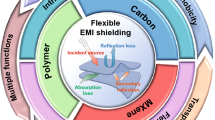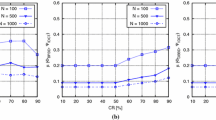Abstract
An energy efficient communication system is required for the improvement of nanoscale wireless communication. In this paper, we defined minimum energy coding scheme (MEC) to achieve energy efficiency in wireless nanosensor network. MEC maintains the desire code distance to provide reliability and better decoding probability, while requiring less energy to transmit bits of information. We proposed a relationship between transmission rate and decoding rate which is significant for minimum energy channel codes in nanoscale wireless communication. We investigated the performance evaluation of code length limited and energy limited transmission rates on the source cardinality which ensures that for any value of code distance, code length limited transmission rate will be decreased in regard to increasing the value of source cardinality and vice versa for energy limited transmission rate. We studied the optimum value of transmission rate and decoding rate which confirms that if the number of carriers is increased n times, then the optimum transmission and decoding rate would also be increased n times. We also studied the performance evaluation of code distance which is inversely propotional to transmission distance and correct decoding probability. Further, we examined the dependance of average energy per bit which is proportional to symbol duration and bandwidth. On the contrary, spectral efficiency is inversely proportional to symbol duration. We strongly believe that our proposed relationship between transmission rate and decoding rate accompanied by the performance evaluation of various parameters will improve the nanoscale wireless communication system.

source cardinality where l = 1

source cardinality where l = 1

source cardinality where l = 10

source cardinality where l = 10

source cardinality where l = 50: a code length limited transmission rate; b energy limited transmission rate

source cardinality for various carriers: a code length limited transmission rate; b energy limited transmission rate

source cardinality for various carriers: (a) − (c):—code length limited rate:—(a) single carrier, (b) 10 carriers, (c) 50 Carriers; (d) − (f):—energy limited rate:—(d) single carrier, (e) 10 carriers, (f) 50 Carriers


source cardinality: code distance:-(a) 1; (b) 3





Similar content being viewed by others
Code Availability
Not applicable.
Data Availability
The data supporting the findings of this study and its supplementary materials are maximum available within the manuscript and others not to disclose.
References
Jornet, J. M., & Akyildiz, I. F. (2011). Channel modeling and capacity analysis for electromagnetic wireless nanonetworks in the terahertz band. IEEE Transactions on Wireless Communications. https://doi.org/10.1109/TWC.2011.081011.100545].
Akyildiz, I. F., Brunetti, F., & Blázquez, C. (2008). Nanonetworks: A new communication paradigm. Computer Networks, 52, 2260–2279.
Hanson, G. W. (2005). Fundamental transmitting properties of carbon nanotube antennas. IEEE Transactions on Antennas and Propagation, 53, 3426–3435.
Atakan, B., & Akan, O. B. (2009). Carbon nanotube sensor networks. Com: IEEE Nano.
Akyildiz, I. F., & Jornet, J. M. (2010). Electromagnetic wireless nanosensor networks. Nano Communication Networks, 1(1), 3–19.
Jornet, J. M., Akyildiz, I. F., (2010). Channel capacity of electromagnetic nanonetworks in the Terahertz band. In 2010 IEEE international conference on communications (pp. 1–6). Cape Town. https://doi.org/10.1109/ICC.2010.5501885.
Kocaoglu, M., & Akan, O. B. (2013). Minimum energy channel codes for nanoscale wireless communications. IEEE Transactions on Wireless Communications. https://doi.org/10.1109/TWC.2013.022113.2190.
Hossain, Md. B., Podder, E., Adhikary, A., & Mamun, A. A. (2018). Optimized hexagonal photonic crystal fibre sensor for glucose sensing. Advances in Research, 13(3), 1–7. https://doi.org/10.9734/AIR/2018/38972.
Adhikary, A., Podder, E., Hossain, Md. B., Mondal, H. S., & Aslam Uddin, K. M. (2018). A project report on downstream transmission performance of GPON. Asian Journal of Advanced Research and Reports, 1(1), 1–11. https://doi.org/10.9734/AJARR/2018/40806.
Hossain, M. B., Adhikary, A., & Khan, T. Z. (2020). Performance Investigation of Different Dispersion Compensation Methods in Optical Fiber Communication. Asian Journal of Research in Computer Sciences, 5(2), 36–44. https://doi.org/10.9734/AJRCOS/2020/v5i230133].
Adhikary, A., Hossain, M. B., Khan, T. Z., Soheli, S. J., & Khan, M. A. R. (2020). Performance analysis of Q-factor on wavelengths and bit rates using optical solitons with dispersion management. Journal of Optics, 49(4), 533–542. https://doi.org/10.1007/s12596-020-00646-y.
Kocaoglu, M., Akan, O. B., (2012). Minimum energy coding for wireless nanosensor networks. In 2012 proceedings IEEE INFOCOM (pp. 2826–2830). Orlando, FL. https://doi.org/10.1109/INFCOM.2012.6195709.
Kocaoglu, M., Malak, D., (2012). On the node density limits and rate-delay-energy tradeoffs in ad hoc nanonetworks with minimum energy coding. In 2012 IEEE international workshop on molecular and nanoscale communications (pp. 6157–6161). Ottawa, Canada.
Jornet, J. M., Akyildiz, I. F., (2012). Low-weight channel coding for interference mitigation in electromagnetic nanonetworks in the terahertz band. In 2011 IEEE international conference on communications (ICC) (pp. 1–6). Kyoto. https://doi.org/10.1109/icc.2011.5962987.
Prakash, Y., Gupta, S. K. S., (2003). Energy efficient source coding and modulation for wireless applications. In 2003 IEEE wireless communications and networking (vol. 1, pp. 212–217). WCNC 2003. New Orleans, LA, USA. https://doi.org/10.1109/WCNC.2003.1200347.
Jornet, J. M., Akyildiz, I. F., (2010). Graphene-based nano-antennas for electromagnetic nanocommunications in the terahertz band. Proc. 4th European Conference on Antennas and Propagation.
Carrasco, S. C., Sanchez, A. J. G., & Haro, J. G. (2018). A nanoscale communication network scheme and energy model for a human hand scenario. Nano Communication Networks, 15, 17–27. https://doi.org/10.1016/j.nancom.2018.01.005.
Galal, A., & Hesselbach, X. (2018). Nano-networks communication architecture: Modeling and functions. Nano Communication Networks, 17, 45–62. https://doi.org/10.1016/j.nancom.2018.07.001.
Ogbebor, J. O., Imoize, A. L., & Atayero, A. A. A. (2020). Energy Efficient Design Techniques in Next-Generation Wireless Communication Networks: Emerging Trends and Future Directions. Wireless Commun. and Mobile Computing. https://doi.org/10.1155/2020/7235362.
Zainuddin, M. A., Dedu, E., & Bourgeois, J. (2016). Low-weight code comparison for electromagnetic wireless nanocommunication. IEEE Internet of Things Journal, IEEE, 3(1), 38–48.
Funding
This work was not supported by anyone. It was our own work.
Author information
Authors and Affiliations
Contributions
Not applicable (Optional).
Corresponding author
Ethics declarations
Conflicts of interest
We have no conflicts of interest to disclose.
Additional information
Publisher's Note
Springer Nature remains neutral with regard to jurisdictional claims in published maps and institutional affiliations.
Rights and permissions
About this article
Cite this article
Adhikary, A., Hasan, R., Hossen, K. et al. Performance Analysis of Transmission Rate and Decoding Rate Using Minimum Energy Channel Codes for Nanoscale Wireless Communication. Wireless Pers Commun 118, 1343–1364 (2021). https://doi.org/10.1007/s11277-021-08079-x
Accepted:
Published:
Issue Date:
DOI: https://doi.org/10.1007/s11277-021-08079-x




